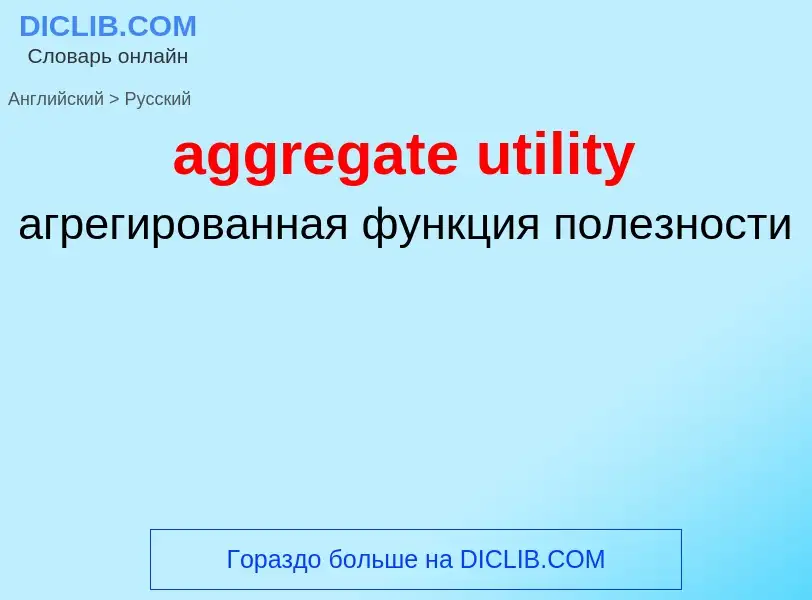Перевод и анализ слов искусственным интеллектом
На этой странице Вы можете получить подробный анализ слова или словосочетания, произведенный с помощью лучшей на сегодняшний день технологии искусственного интеллекта:
- как употребляется слово
- частота употребления
- используется оно чаще в устной или письменной речи
- варианты перевода слова
- примеры употребления (несколько фраз с переводом)
- этимология
aggregate utility - перевод на русский
2) практичность, выгодность || экономически выгодный, рентабельный
3) мат. функция полезности
4) pl предприятия общественного пользования, коммунальные предприятия
5) pl коммунальные услуги; коммунальные службы
6) pl акции и облигации предприятий общественного пользования
7) универсальный, общего назначения
8) дешёвый, невысокого качества
- utility of money
- absolute utility
- acceptable utility
- additive utility
- aggregate utility
- cardinal utility
- computer utility
- consumer utility
- cumulative utility
- decreasing utility
- diminishing utility
- diminishing marginal utility
- distribution utilities
- electric utilities
- form utility
- gas utilities
- incommensurable utilities
- incremental utility
- information utilities
- marginal utility
- marginal utility of money
- maximax utility
- maximin utility
- maximum utility
- minimax utility
- municipal utilities
- ordinal utility
- ownership utility
- place utility
- possession utility
- producer utility
- public utilities
- publicly-owned electric utilities
- sampling utility
- separable utility
- service utility
- social utility
- subjective utility
- time utility
- transportation utilities
- urban gas utilities
- water utilities
Определение
Википедия

Construction aggregate, or simply aggregate, is a broad category of coarse- to medium-grained particulate material used in construction, including sand, gravel, crushed stone, slag, recycled concrete and geosynthetic aggregates. Aggregates are the most mined materials in the world. Aggregates are a component of composite materials such as concrete and asphalt; the aggregate serves as reinforcement to add strength to the overall composite material. Due to the relatively high hydraulic conductivity value as compared to most soils, aggregates are widely used in drainage applications such as foundation and French drains, septic drain fields, retaining wall drains, and roadside edge drains. Aggregates are also used as base material under foundations, roads, and railroads. In other words, aggregates are used as a stable foundation or road/rail base with predictable, uniform properties (e.g. to help prevent differential settling under the road or building), or as a low-cost extender that binds with more expensive cement or asphalt to form concrete. Although most kinds of aggregate require a form of binding agent, there are types of self-binding aggregate which do not require any form of binding agent.
In Europe, sizing ranges are specified as d/D, where the d shows the smallest and D shows the largest square mesh grating that the particles can pass. Application-specific preferred sizings are covered in European Standard EN 13043 for road construction, EN 13383 for larger armour stone, EN 12620 for concrete aggregate, EN 13242 for base layers of road construction, and EN 13450 for railway ballast.
The American Society for Testing and Materials publishes an exhaustive listing of specifications including ASTM D 692 and ASTM D 1073 for various construction aggregate products, which, by their individual design, are suitable for specific construction purposes. These products include specific types of coarse and fine aggregate designed for such uses as additives to asphalt and concrete mixes, as well as other construction uses. State transportation departments further refine aggregate material specifications in order to tailor aggregate use to the needs and available supply in their particular locations.
Sources for these basic materials can be grouped into three main areas: mining of mineral aggregate deposits, including sand, gravel, and stone; use of waste slag from the manufacture of iron and steel; and recycling of concrete, which is itself chiefly manufactured from mineral aggregates. In addition, there are some (minor) materials that are used as specialty lightweight aggregates: clay, pumice, perlite, and vermiculite.




